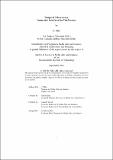Temporal Telepresence: Immersive Interfaces for TeleAbsence
Author(s)
Pillis, D.
DownloadThesis PDF (6.039Mb)
Advisor
Ishii, Hiroshi
Wood, Danielle
Terms of use
Metadata
Show full item recordAbstract
To store the past in a simulation may enable greater understanding of ourselves, our stories, and our histories. The urge to capture our past into networks of photographic, written, filmed, and object-based narratives has long been a means for individuals to identify change, growth, and gain perspective on themselves. Using a dataset of human narratives derived from records and ephemera, this thesis explores a novel approach to preserving and interacting with memories. We present an interactive system of objects and applications that supports intergenerational memory preservation by enabling individuals to actively explore the relationship between personal artifacts, photographs, the spaces of their past, and their memories. This system integrates personal digital twins, photogrammetry, Gaussian splatting, and tangible interfaces to create a new way of experiencing the past, based on interactivity with architectural artifacts and simulations from an individual’s life. Using an iterative participatory design process, we developed a set of multisensory interaction experiences that allow individuals to explore their relationship to autobiographical memory. The system dynamically links autobiographical memories with the environments where they took place, responding to text, photo, and object-based interactions. This experience invites individuals to modify their recollections by exploring how photo, video, and 3D space relate to the experience of revisiting narratives from the past. Applications of this system include assisting with dementia, aging, memory loss, and Alzheimer’s. Our initial studies were promising. When using the simulation system, individuals spent more time reminiscing, discussing more memories, and experiencing greater presence in their recollections than without the interactive paradigm. The system also encouraged family members to reinforce their memories by actively re-encoding them through the simulation interfaces. Results demonstrated that presence in memories seemed more vivid, detailed, and spatially accurate than before the intervention. The result is a new memory-sharing experience that benefits individuals and families by allowing them to understand how their interactions with the past can be enriched through the integration of artifacts and simulations that impact the development of autobiographical memory.
Date issued
2024-09Department
Program in Media Arts and Sciences (Massachusetts Institute of Technology)Publisher
Massachusetts Institute of Technology